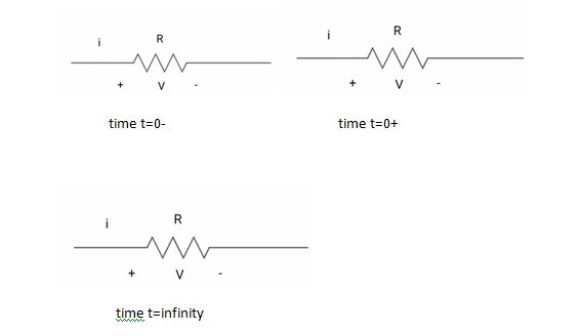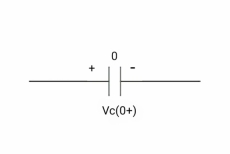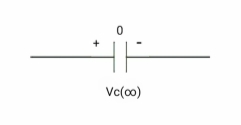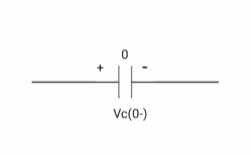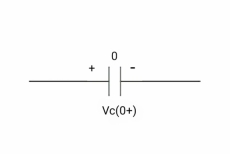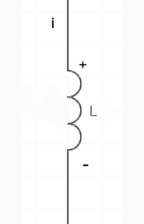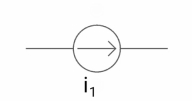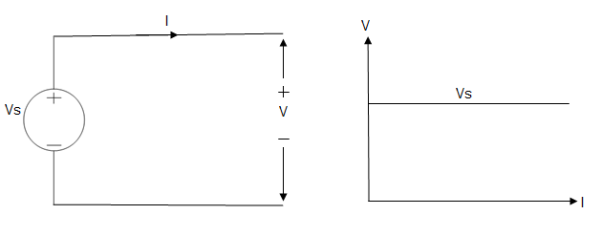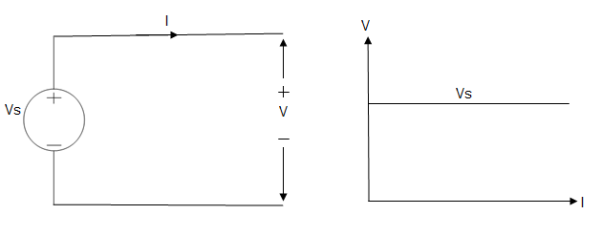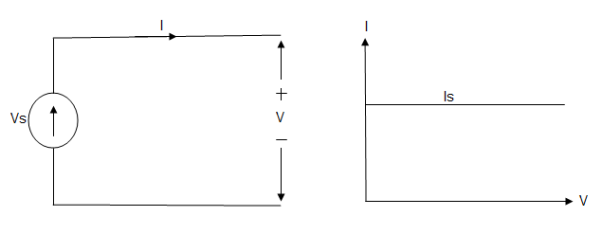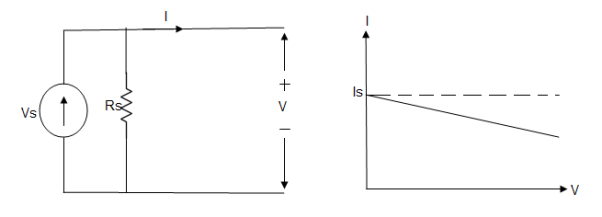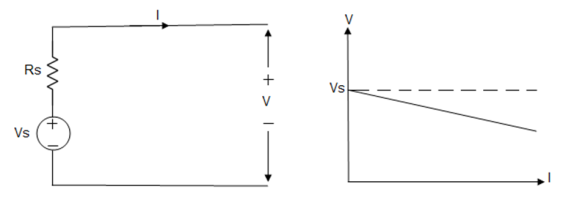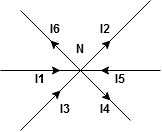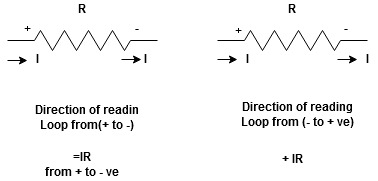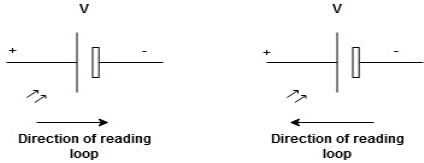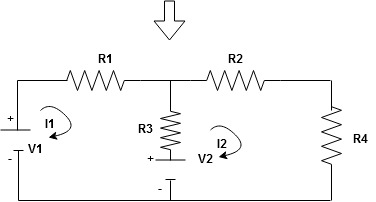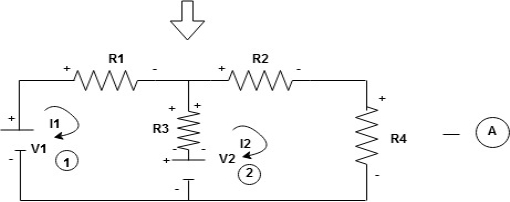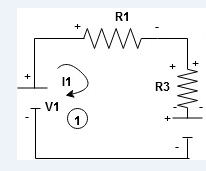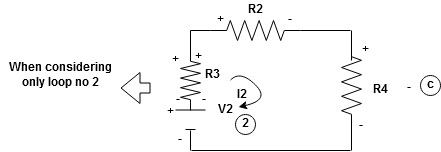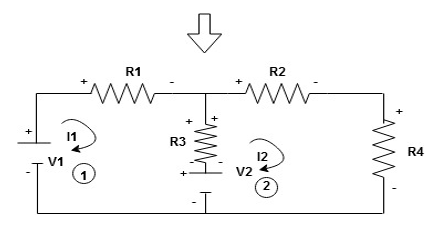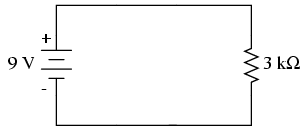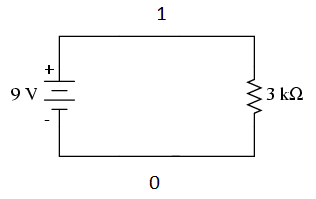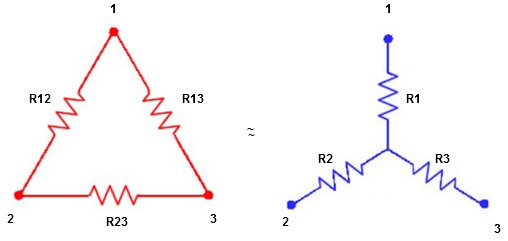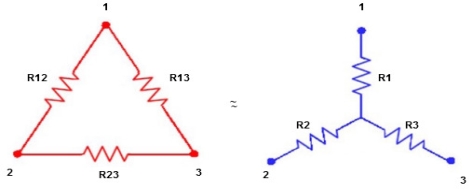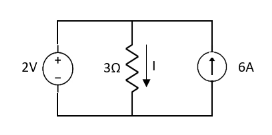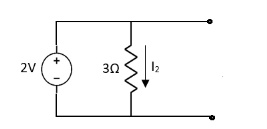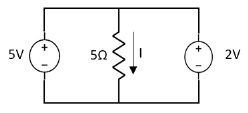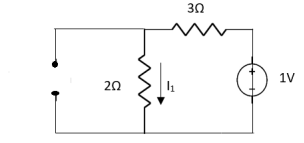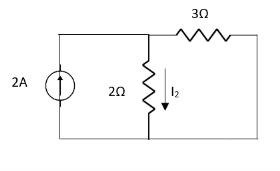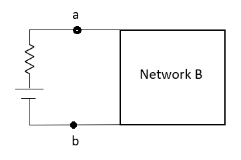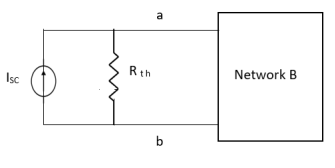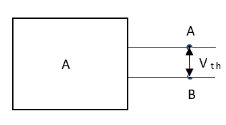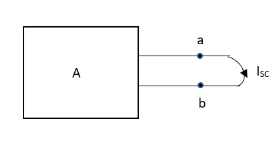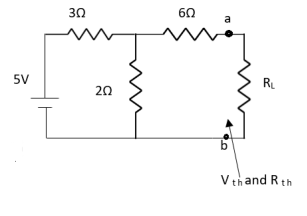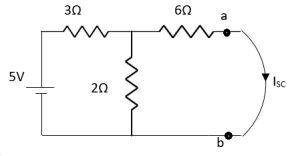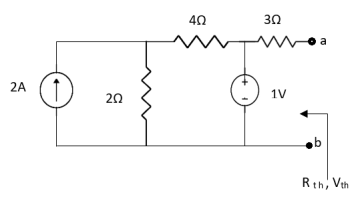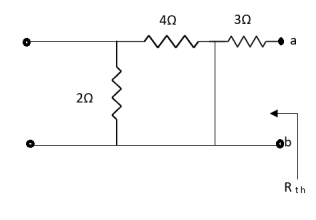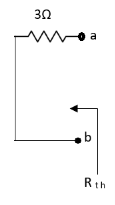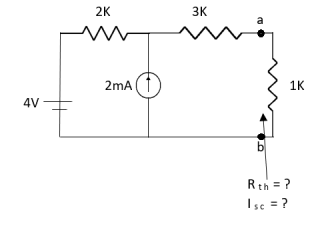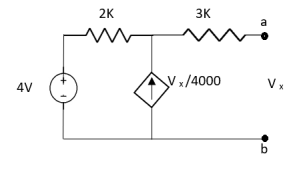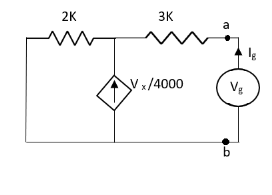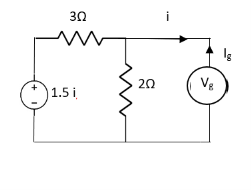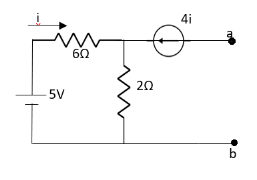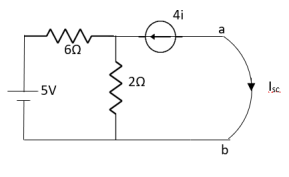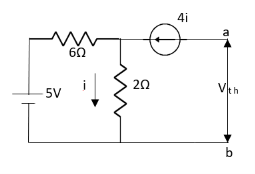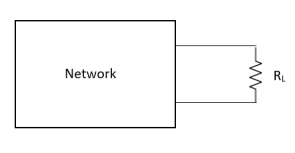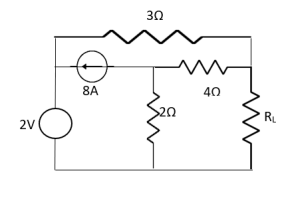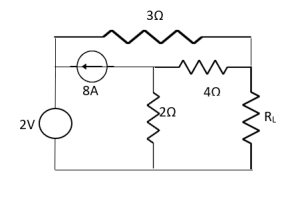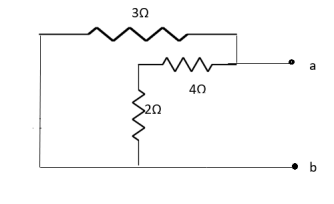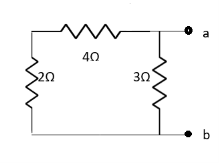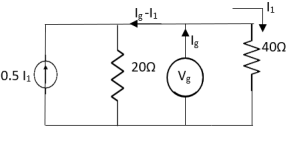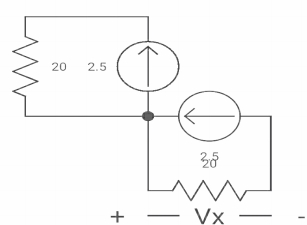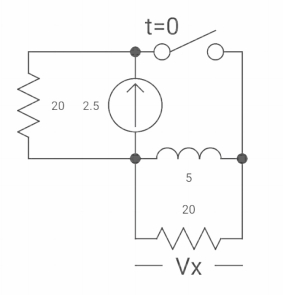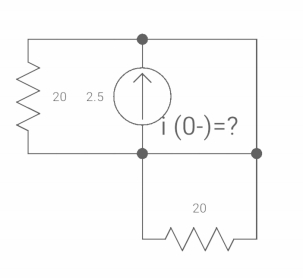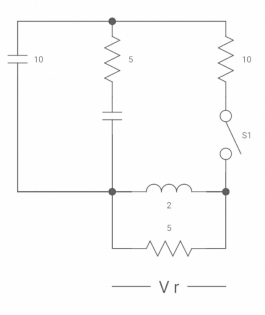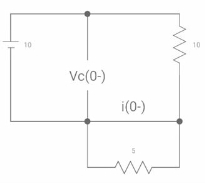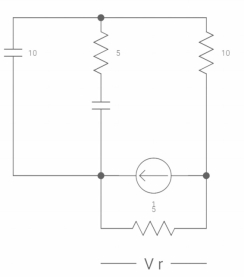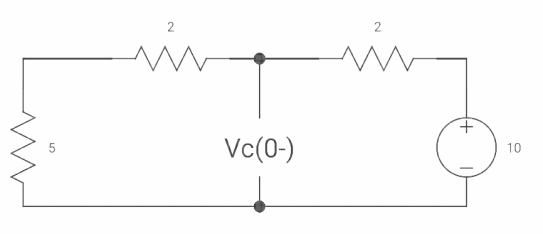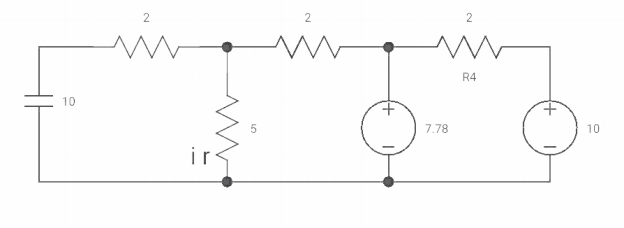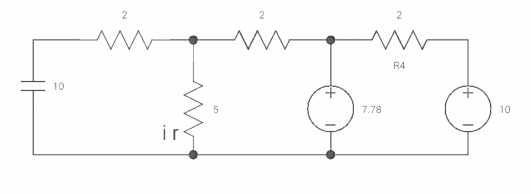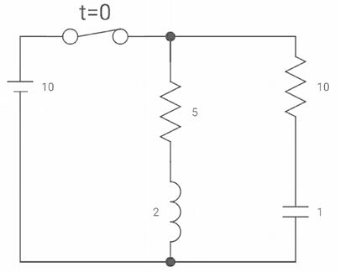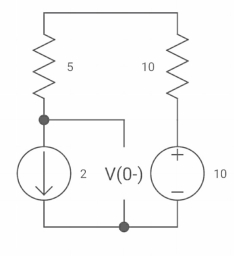Unit – 1
DC Circuits
|
# In case of capacitor: -
At time t= 0-
|
:. Capacitor is initially uncharged
Q (0-) =0
Q=cv Q (0-) = cvc (0-) Vc (0-) =0 |
At time t= 0+
|
By low of conservation of charges
Q (0-) = Q (0+) Cvc (0-) =cvc (0+) Vc (0+) =0 |
Hence acts as
|
If capacitor is initially uncharged at t= 0- than voltage across capacitor is zero at t=0+ capacitor will follow low of consvation of charges and Vc (0+) =0 it means at t=0+ capacitor behaves as short circuit in other words, voltage across capacitor cannot change instantaneously.
At time t= infinity,
|
|
I = cdvc/dt constant and maximum |
hence, i= 0
At t= infinity capacitor will be fully charged or voltage across capacitor is constant and current through capacitor is zero so, capacitor will behave as open –circuit
Say capacitor is initially charged
|
at time t= 0-,
|
at time t= 0+,
|
at time t= 0+
|
Q (0-) = Q (0+) Cvc (0-) =cvc (0+) V1 = Vc (0+) |
|
Hence acts as
|
Its capacitor is initially charged at t= 0- as voltage across capacitor is V1 than at t=0+ capacitor behaves as a voltage as a voltage source with value V1
At time t = infinity
|
If capacitor is initially charged and it is connected to any independent source for long time than current through capacitor is 3 etw and capacitor will be fully charged and it behaves as o.c
# for Inductor: -
At time t= 0-
|
Ø= Li =0 Ø (0) = Li (0-) i (0-) =0 at t= 0+, |
|
by low of conservation of flux
Ø (0-) = Ø (0+) Li (0-) = Li (0+) 0 =i (0+) |
Hence, acts as short circuit
Ideal and practical Voltage and Current source:
A voltage source is a device which provides a constant voltage to load at any instance of time and is independent of the current drawn from it. This type of source is known as an ideal voltage source. Practically, the ideal voltage source cannot be made. It has zero internal resistance. It is denoted by this symbol.
|
Fig: Voltage source symbol
Ideal Voltage Source
|
Fig: Ideal Voltage Source
The graph represents the change in voltage of the voltage source with respect to time. It is constant at any instance of time.
Voltage sources that have some amount of internal resistance are known as a practical voltage source. Due to this internal resistance, voltage drop takes place. If the internal resistance is high, less voltage will be provided to load and if the internal resistance is less, the voltage source will be closer to an ideal voltage source. A practical voltage source is thus denoted by a resistance in series which represents the internal resistance of source.
Practical Voltage source
|
Fig: Practical Voltage source
The graph represents the voltage of the voltage source with respect to time. It is not constant but it keeps on decreasing as the time passes.
Current source
A current source is a device which provides the constant current to load at any time and is independent of the voltage supplied to the circuit. This type of current is known as an ideal current source; practically ideal current source is also not available. It has infinite resistance. It is denoted by this symbol.
Ideal Current source
|
Fig: Ideal Current source
The graph represents the change in current of the current source with respect to time. It is constant at any instance of time.
Why ideal Current source has infinite resistance?
A current source is used to power a load, so that load will turn on. We try to supply 100% of the power to load. For that, we connect some resistance to transfer 100% of power to load because the current always takes the path of least resistance. So, in order for current to go to the path of least resistance, we must connect resistance higher than load. This is why we have the ideal current source to have infinite internal resistance. This infinite resistance will not affect voltage sources in the circuit.
Practical Current source
Practically current sources do not have infinite resistance across there but they have a finite internal resistance. So the current delivered by the practical current source is not constant and it is also dependent somewhat on the voltage across it.
A practical current source is represented as an ideal current source connected with resistance in parallel.
|
Fig; Practical Current source
The graph represents the current of the current source with respect to time. It is not constant but it also keeps on decreasing as the time passes.
Examples of current and voltage sources
The examples of current source are solar cells, transistors and examples of some voltage sources are batteries and alternators.
This was all about ideal and practical sources of power. The ideal sources are very useful for calculations in theory but as ideal sources are not practically possible, only practical sources are used in practical circuits. The batteries we use are a practical source of power and the voltage and current decreases as we use it. Thus both are useful to us in their own ways.
|
The algebraic sum of currents meeting at a junction or node in a electric circuit is zero or the summation of all incoming current is always equal to summation of all outgoing current in an electrical network.
Explanation
|
Assuming the incoming current to be positive and outgoing current negative we have
|
I e incoming current = ∑ outgoing current thus, the above Law can also be stated as the sum of current flowing towards any junction in an electric circuit is equal to the sum of currents flowing away from that junction
incoming current = ∑ outgoing current thus, the above Law can also be stated as the sum of current flowing towards any junction in an electric circuit is equal to the sum of currents flowing away from that junction
Kirchhoff’s Voltage Law (KVL)
statement : the algebraic summation of all Voltage in any closed circuit or mesh of loop zero.
ie ∑ Voltage in closed loop = 0 the summation of the Voltage rise (voltage sources) is equal to summation of the voltage drops around a closed loop in 0 circuit for explanation from here
determination of sigh and direction of currents (Don’t write in exams just for understanding)
|
current entering a resistor is +ve and leaving should be –ve
now
|


Potential Rise Potential Drop
|
We are reading from +V to –V we are reading from –V to +V
 potential drops
potential drops  potential rise
potential rise
 -V
-V  +V
+V
Given Circuit
|
First identify no of loops and assign direction of current flowing in loop
Note : no of loops in circuit = No, of unknown currents = no, of equations in the circuit
|
Note : keep loop direction and current direction same ie either clockwise or anticlockwise for all loops I1 I2
Now according to direction of direction assign signs (+ve to –ve) to the resistors
|
Note : voltage sources (V) polarities does not change is constant.
Note: for common resistor between 2 loops appearing in the circuit like R3 give signs according to separate loops as shown
|
When considering only loop no 1 (+ R3 - )
- B
|
Now consider diagram A and write equations
Two loops  two unknown currents
two unknown currents  two equation
two equation
Apply KVL for loop ① [B. Diagram ]
(+ to drop -) = - sign and (- to rise +) = + sign
 for drop = -sign
for drop = -sign
 for rise = + sign
for rise = + sign
- |
-( ) R2 is considered because in R3,2 currents are flowing
) R2 is considered because in R3,2 currents are flowing  and
and  and we have taken (
and we have taken ( ) because we are considering loop no 1 and current flowing is
) because we are considering loop no 1 and current flowing is  in loop no 1
in loop no 1
 )
)
Similarly for loop no. 2 currents flowing is  resistor R3 it should be
resistor R3 it should be  )R3
)R3
|
Consider loop no. 1 apply KVL - - Consider loop no. 2 apply KVL - - |
After solving equation ① and ② we will get branch current  and
and 
Here is a simple circuit with DC excitation:
|
Analysis would mean we determine the voltages at all the nodes and currents in all the branches of this circuit.
A node is defined as any point where two or more components meet.
A branch is defined as any path between two nodes.
Let’s label all the nodes in the circuit above:
|
We have only two nodes here, ‘1’ and ‘0’.
We call node ‘0’ the ground node. The ground node is at 0 volt.
Node ‘1’ is connected to the top of our DC voltage source. So it is at 9 volts.
Half our job is done here, because we now know the voltages at all the nodes in our circuit.
Next, let’s talk about the branches.
There are two branches in our circuit. One branch contains the 9V DC source and the other branch contains the 3k resistor.
We know find the currents through the branches.
From Ohm’s law we can calculate the current in the resistor.
I = V/R
This gives us a current of 9/3k = 3 mA.
The current in the resistor branch is 3 mA. And, because our circuit is one single closed loop, this current also flows in the other branch.
At this point, we know all the voltages at each node and the currents through each branch of our simple circuit. So, we say that the analysis of our simple DC excitation circuit is complete.
Star to delta conversion to final equivalent resistance
|
We know that (from delta to star conversion) R1 =
R2 =
R1 =
Multiply ① X ② L.H.S and R.H.S
R1 R2 =
Similarly multiply ② X ③
R2 R3 =
And ③ X①
R1 R3 =
Now add equation ④, ⑤, and ⑥ L.H.S and R.H.S
|
(Delta) | ||
Similarly R23 = R2+R3 +
R23 = R1+R2 + | ||
- Delta to Star Conversion to Find (Req.)
|
Delta = R12// (R23 + R13) =R1 + R2
=
= Here let R = R12 + R23 + R13
=
Now the 3 equations after equating L.H.S. and R.H.S R1 + R2 =
R2 + R3 =
| |
R1 + R3 =
Now subtract ② and ① on L.H.S. and R.H.S
R2+ R3 – R1 – R2 =
Now add equation ④ and ③
R3 – R1 + R1 + R3 =
2R3 =
Similarly R1 =
And R2 = R23 R12/R where R = R12 + R23 + R13 | |
ie star equivalent from delta network is ratio of product of adjacent branches in delta to the addition of all branches in delta.
Superposition Theorem
- This is only applicable to circuits with linear elements.
- If two or more than two independent sources (voltage or current) are operating in the circuit than voltage across any element or current through any element is sum of current and voltages due to individual sources.
Question 1. Find the current through  resistance.
resistance.
|
Solution:
|
 1= 0
1= 0
|
|
Special Case:
|
Since two voltage sources with different magnitude in parallel which cannot be connected as in single branch two different current is not possible (if 5V than I = zero).
Question:
|
|
|
= | ||
= | ||
Thevenin’s and Norton’s Theorem
|
Thevenin’s equivalent of A
|
Norton’s equivalent of A
|
|
- equivalent circuit.
CONDITIONS FOR APPLICATION
- For network A:
- Network A should contain linear elements.
- Network A can have independent and dependent current and voltage source.
- If network A has dependent source than controlling parameter must lie in network A itself.
- Network A should not have any source coupling and magnetic coupling.
- For network B:
- It can have linear and non linear elements.
- It can have dependent and independent voltage and current sources.
- It should not have any source and magnetic coupling with network A.
Method for finding Rth :
Firstly, open circuit terminal A and B.
- If network is operating with only independent sources:
- Make all sources zero in network A.
- Find out the equivalent resistance across terminal A and B.
2. If network A is operating with independent and dependent sources:
- Make all independent sources zero in network A.
- Connect a generation between A and B.
3. If network is operating with only dependent sources:
Connect generation between A and B
|
Method for Vth:
First open circuit terminal A and B.
Find out the voltage between A and B this is Vth
|
Method for Isc:
- Isc =

- Remove network B and S.C. the terminal A and B and current from terminal A to B Isc.
|
Question:
|
Answer:
|



|
| |
| |
Finding Isc from circuit directly:
|
By KCL, |
|
Question:
Answer
|
|
|
Also, clear from circuit that Vth = 1V.
|
By applying KVL we get,
1-3Isc=0 | ||
Isc= | ||
Que:
|
Ans;
|
Rth=3k+2k=5k
By applying KVL we get | ||
Therefore, | ||
Question:
|
Solution: For Rth
|
By KCL, But, | ||||
By KVL, | ||||
| ||||
Question:
|
Solution: Since, no independent source is present so,
Isc = 0
And we know that,
Since Rth cannot be zero |
|
But |
|
Question: Find out the Norton’s equivalent
|
Solution:
|
|
Since, there is no significance of current source | |||
| |||
| |||
Maximum Power Transfer Theorem
|
|
where Rth is Thevenin’s equivalent resistance across a and b.
|
Maximum power is absorbed by ZL when
Condition: 
Comparing real and imaginary parts OR Maximum power absorbed by ZL is
Question: Find out the value of load resistance if power absorbed is maximum. |
|
Solution: find Thevenin’s equation
|
|
|
| ||
| ||
Question: Find maximum power delivered is RLif its value is
|
- 16Ω
 Ω
Ω- 60Ω
- 20Ω
Solution
|
| |||
| |||
Therefore, | |||
The transient response means the change in the response of output with respect to time. So, using initial conditions, and solution for differential equations we solve some numerical.
Diagram
|
If switch ‘s’ closed at t= 0 find out the voltage across capacitor and current through capacitor at t= 0+?
Soln: at t= 0- switch was open so,
|
:. There is no potential so Vc (0-) = 0
At t= 0+, Vc (0-) = Vc (0+) = 0
Diagram
|
Isc = 10/5 = 2 A |
Diagram
|
The switch was closed for long time before
Opening at t=0- find VX (0+)?
(a) 25V (b) 50 V (c)-50V (d) 0V
soln at time t=0-
|
clearly, il (0-) = 2.5 A
at t= 0+, as inductor is initially charges
so il (0-) = il (0+)
|
-VX= 20/2.5 20*2.5 VX= -50A |
Ques:
|
VR (0+) = dil/dt(t) = 0+? |
If switch is opened at t= 0?
Soln: -
|
At t=0- Vc (0-) = 10V IL (0-) = 10/10 = 1 A Also, iL (0-) = iL (0+) = 1A |
|
VR(0+) = 5V Ldi(t)/dt = VL (t) DiL(t)/dt = VL(t)/L At t= 0+ d/dt iL (0+) = VL (0+)/L | ||||
-VL (0+)-VR =0 VL (0+) = -5V dt(t) at t = ot = vl (ot)/L =-5/2 | ||||
dil/dt(o+) = 2.5 A/s | ||||
|
Vc(o+) and iR (o+) it switches ‘s’ is closed at t=0?
At t=0
|
As capacitor is fully charged so acts as
Vc (0-) = 7*10/7+2 = 70/9v |
At t=0+
|
Vc (0+) = Vc (0) = 40/9v
By applying kcl at A,
VA-10/2+ VA/5+VA-7019/2 =0 VA [1/5+1/2+1/2] = 5+35/9 Va [6/5] = 80/9 Va= 400/54v IR (0+) = Va/5 = 400/54*5 = 80/54 A |
Reference Books
- D. P. Kothari and I. J. Nagrath, “Basic Electrical Engineering”, Tata Mcgraw Hill, 2010.
- D. C. Kulshreshtha, “Basic Electrical Engineering”, Mcgraw Hill, 2009.
- L. S. Bobrow, “Fundamentals Of Electrical Engineering”, Oxford University Press, 2011.
- E. Hughes, “Electrical And Electronics Technology”, Pearson, 2010.
- V. D. Toro, “Electrical Engineering Fundamentals”, Prentice Hall India, 1989.
- Basic Electrical Engineering by Fitzerald, Et Al, Tata Mcgraw Hill
- Fundamentals of Electrical Engg. By R. Prasad, Phi Publication
- Basic Electrical Engineering by V.K. Mehta And Rohit Mehta, S.Chand Publication
